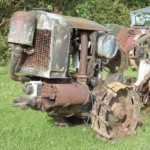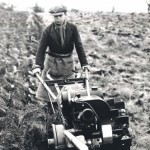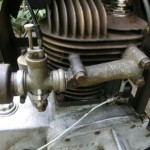Home › Forums › General › Help and information › Identification needed for unknown engine
- This topic has 35 replies, 5 voices, and was last updated 4 years, 4 months ago by
 trusty220.
trusty220.
-
AuthorPosts
-
November 28, 2019 at 7:42 am #32752
 charlieKeymaster
charlieKeymasterIt might be worth sending some photos and information to Patrick Knight for him to write an article to go in Stationary Engine magazine.
November 28, 2019 at 3:39 pm #32753 trusty220Keymaster
trusty220KeymasterNot a bad idea, Charlie. I’ll wait until I’ve dismantled it completely first before I start to put pen to paper.
I’ve treated it to a steam clean at work today so tonight’s effort won’t be quite so difficult (I hope). I’m starting to wish that I’d left the muck on now!
November 28, 2019 at 9:44 pm #32754 trusty220Keymaster
trusty220KeymasterThis engine definitely isn’t giving up it’s secrets easily. I’ve spent hours tonight trying to get the two halves of the crankcase apart and finally succeeded. The problem is that all of the bolts are badly wasted away and are in such inaccessible positions that you can’t get any tools near them to remove them. In the end I had to resort to grinding part of each one’s nut away so that I could split the nut and gently tap the bolt out of it’s hole. That worked for four of them, but there are six in all and I had to drill one bolt out and chop the other one piecemeal.
I was asked today what was on the reverse side of the flywheel- nothing, but here’s the photo.
November 28, 2019 at 11:26 pm #32762 wristpinParticipant
wristpinParticipantProgress indeed. I like the suggestion of sharing the question of identification with the Stationary Engine brigade.
Off topic, but is that a Champion plug cleaner and pressure tester in the back ground?November 29, 2019 at 7:49 am #32763 trusty220Keymaster
trusty220KeymasterIn the background is a drill press and my Clarke compressor/jump start pack behind that. Unless you’re referring to an earlier photo with the Tecumseh ignition tester in a purpose-made case?
Not home and dry yet, but much closer. I’m not too concerned about the surface rust on the crankshaft and camshaft gears. It can make things look much worse than they are, but the main concern will be the state of the big-end bearing surface. This weekend will be interesting!
I don’t suppose anybody reading this can identify any single part of this engine. I think it’s a one-off, probably hand built but using certain items off-the-shelf to speed up the build. That’s why I thought it looked similar to a Villiers because the cowlings seemed to follow their design, and they may well have been “borrowed” to fill a need, but very little else on this engine would suggest Villiers to me. The use of left-handed threads would suggest an engineer’s input because production would try to make the engine as simple and cheaply as possible; I forgot to mention that the governor shaft is located with a left-handed 5/16″ bolt as well as the flywheel nut.
November 30, 2019 at 12:33 pm #32764 trusty220Keymaster
trusty220KeymasterI’ve now got as far as I can get with it. The crankshaft is out, the big end is off, camshaft out and the barrel removed from the crankcase. One thing that I can’t seem to do at the moment is to unstick the piston from the bore as it’s corroded itself together. I don’t want to damage either and so excess force is out of the question, at least for now until I’ve tried everything else.
The next part of the process will be to boil the assembly in oil in an effort to free the piston; usually I would put the whole lot in acid but the piston is aluminium and won’t survive that process! The crankshaft, camshaft and magneto drive gears are all made of steel and are being acid stripped as we speak, so they should look half decent shortly.
The connecting rod has some numbers cast into it and the crankshaft has also got some numbers and a logo stamped onto the surface. I’ve tried to take photo’s of both, but hopefully the crankshaft numbers will be more legible without the rust.
I’ve taken a photo of a very messy workbench for you, Angus! You can see that I’ve not had time to have a tidy up whilst dragging this lump apart, but I can assure you that all is now spick and span and waiting for the next stage which will be the boiling oil.
Now, where’s Mrs. Geoff? Do you think she’ll miss this big saucepan……?
November 30, 2019 at 2:38 pm #32773andyfrost
ParticipantGeoff , there may be one minute clue there , the pic of what I’m assuming is a big end shell has the prefix 86 stamped into it.
86 was a prefix number used by BSA in alot of their part numbers , I may be miles of track , and it could even be a hepolite number.
I t would be well worth your while speaking to Paul Childs at Meetens , and quoting him that part number to see if it matches anything to do with BSA.Andy.
December 1, 2019 at 8:27 am #32778 charlieKeymaster
charlieKeymasterAndy is right, I have had a look and found 86 3519 is connecting rod bush big end for a BSA 220cc unit, model D. However that engine had a flywheel magneto.
December 1, 2019 at 5:28 pm #32782 trusty220Keymaster
trusty220KeymasterI think I’m leaning towards the prototype camp still. I have just sent Paul Childs an email detailing all of the part numbers that I’ve found inside the engine. We’ll see if he can identify it from the photo’s, otherwise it may be that the person that built it used a combination of parts from established manufacturers to cut down the cost of developing a new engine.
All of the steel parts are now being gently stripped in the acid bath. The piston has flatly refused to budge from it’s safe little hideout in the barrel and so I’ve given it a bath in boiling oil for an hour this afternoon to try to free it off. It will have a soak in the cooling oil for 24 hours then I’ll have another go at it; if all else fails then I’ll put it under the press to see if it will move, but that will be a last resort and only if I know that I can get a replacement piston (just in case!).
Has anybody successfully managed to clean aluminium castings gently by soaking them, or is the only way to do it with a brass brush and lots of elbow grease?
December 1, 2019 at 5:45 pm #32783andyfrost
ParticipantGeoff , you may well be correct regarding the sourcing of various parts from a number of different manufacturers. One BSA part need not make it a BSA engine.
I recall many years back doing the mechanical work on a Scammel fire pump engine for a chap , I fitted some new big end shells in it , a perfect fit straight out of the packet…….their listed fitment was for a Hillman Imp. Mr Childs may well throw some light on this mystery, there are few people , if any , that know more about British engines than him.Andy.
December 1, 2019 at 9:33 pm #32784 trusty220Keymaster
trusty220KeymasterThanks for that, Andy. No doubt you remember the track rod ends fitted to the Ransomes Motor Triple- they were off the Hillman Imp as well!
December 2, 2019 at 9:28 pm #32785 wristpinParticipant
wristpinParticipantThat bushing with 86-3519. Villiers used 86 and 87-xxxx numbers for quite a few parts, including the crank oil seals on F15s,but on the other hand they may have been their suppliers part numbers. Probably in the 80s I did a complete overhaul on a Monro- Tiller which included having a new axle machined up from scratch and the chap doing the machining for me consulted some tome and found that a Lister bushing ( little end, I think) was just what was needed for replacing those in the MT hull.
December 4, 2019 at 7:49 am #32789 trusty220Keymaster
trusty220KeymasterNo pictures this time, but I’ve managed to separate the piston from the barrel. After boiling in oil then cooling down for 24hrs whilst still in the oil bath I was just cleaning it off ready to have another look at it; tapping with a piece of wood onto the piston got me nowhere and I was thinking of taking it to work to press it out when I had an idea.
Out came my biggest G-clamp and with a piece of wood across the base of the barrel I wound the foot down onto the piston crown. I did it as tight as I could by hand and still no movement; next stage I gave the end of the G-clamp a sharp tap with a copper mallet and the G-clamp came loose! Two or three repeats and I could see definite movement in the piston, so I carried on and it’s now out of the bore.
The piston skirt is scored quite deeply in places and the rings are stuck in. The rust marks show that it was held along the whole length of the piston on the complete circumference, so I think it’s lucky that I got it out with so little damage in the end.
Has anyone got a Hepolite catalogue? The piston has Hepolite cast into the inside of the skirt with a part number of 17529 cast into the other side. Any ideas?
December 4, 2019 at 9:11 am #32793 charlieKeymasterDecember 4, 2019 at 12:11 pm #32796
charlieKeymasterDecember 4, 2019 at 12:11 pm #32796 trusty220Keymaster
trusty220KeymasterI didn’t realise there was no quick reference section, so please don’t waste too much time looking for it.
From the conversations that I’ve had so far with his niece it appears that he only had dealings with BSA Engines, Enfield Engines and Villiers if that narrows it down at all.
-
AuthorPosts
- You must be logged in to reply to this topic.

















